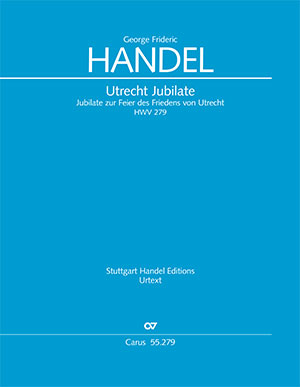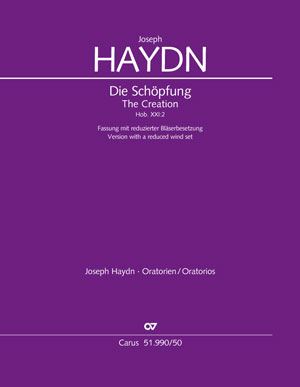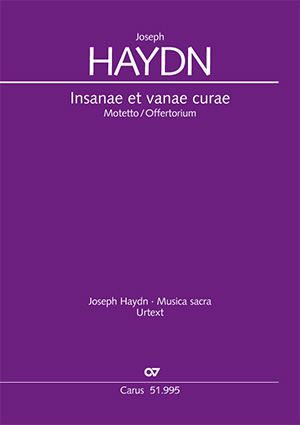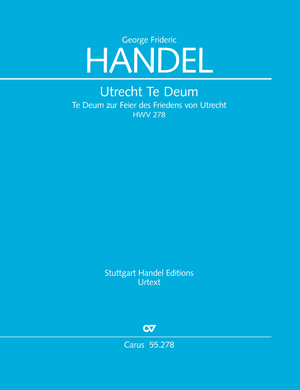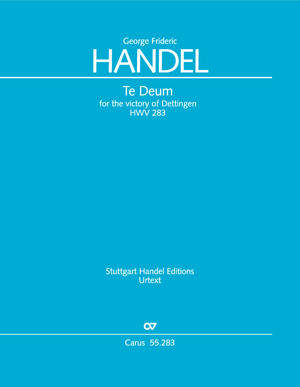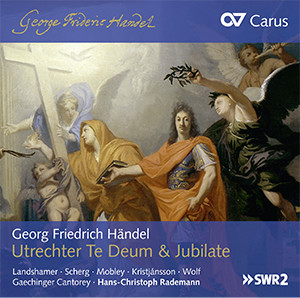Utrechter Jubilate
O be joyful HWV 279, 1713
Handel’s Utrecht Jubilate HWV 279 enthralled London audiences right from its first performance, and it continues to do so today in concert halls and churches all over the world, thanks to the wide range of occasions when it can be performed. It was performed for the first time in a festive service on 7 July 1713 at St. Paul’s Cathedral to celebrate the Peace marking the end of the twelve year-long War of the Spanish Succession. The Utrecht Te Deum and Jubilate were Handel’s first sacred works in English and important milestones at the beginning of his London career.
The edition is based on Handel’s autograph (which unfortunately does not survive) and on a copy from Handel’s circle, which in some respects provides more information than the autograph and contains important details for this edition. In 1717 Handel revised the Jubilate in a smaller scoring for the ensemble at Cannons (HWV 246) and preceded it with a two-part Sinfonia which is also reproduced in the Appendix to this edition. The chorus is mainly scored in four parts, and is in eight parts in just one short movement. In two other movements the soprano part divides. The second alto solo part can also be sung by a high tenor.
The edition is based on Handel’s autograph (which unfortunately does not survive) and on a copy from Handel’s circle, which in some respects provides more information than the autograph and contains important details for this edition. In 1717 Handel revised the Jubilate in a smaller scoring for the ensemble at Cannons (HWV 246) and preceded it with a two-part Sinfonia which is also reproduced in the Appendix to this edition. The chorus is mainly scored in four parts, and is in eight parts in just one short movement. In two other movements the soprano part divides. The second alto solo part can also be sung by a high tenor.
Purchase
Additional product information
-
Composer
Georg Friedrich Händel
| 1685-1759George Frideric Handel put his exceptionally versatile compositional abilities to the test at an early age. After moving to London in 1712, where he was appointed Composer of Musick for His Majesty’s Chapel Royal in 1723, he wrote numerous masterpieces for the royal court as well as his major opere serie. For many years he enjoyed triumphant successes with his operas, which were sung by outstanding performers, with serenades, and later also with oratorios such as Saul and Israel in Egypt. Over the years Handel’s reputation grew far beyond the city where he worked; some of his choral works, particularly Messiah, have enjoyed a performance tradition which remains unbroken to this day, and are sung by choirs throughout the world. Personal details
-
Editor
Uwe Wolf
| 1961Uwe Wolf studied musicology, history, and historical ancillary science at Tübingen and Göttingen. After receiving his doctorate in 1991 he was a research assistant at the Johann-Sebastian-Bach-Institut in Göttingen. From 2004 he worked at the Bach-Archiv Leipzig. There he directed a both research departments, was substantially responsible for the redisigning of the Bach Museum, and he developed the digital Online-Projekt Bach. Since October 2011 he has been the Chief Editor at Carus-Verlag, Stuttgart. He has taught at various universities and also belongs to the editorial boards of several complete editions. Personal details
-
Vocal score arranger
Andreas Gräsle
| 1964Andreas Gräsle (harmonium) studied church music in Stuttgart (organ: Jon Laukvik) and took his concert diploma in organ with Daniel Roth in Saarbrücken, followed by early music studies with Andrea Marcon. He was a scholarship holder of the German Academic Exchange Service (DAAD), and a prizewinner at the International Johann Pachelbel Competition in Nuremberg in 1991. From 1996 to 2003 he was choirmaster and organist at the Augustinuskirche in Schwäbisch Gmünd, and in April 2003 he became district choirmaster in Ditzingen. In addition, he is much in demand as chamber music partner, organist and harpsichordist. He has made several CDs of organ and chamber music, and his own improvisations and arrangements of children’s songs round off his musical activities. He has taught score reading at the Musikhochschule Stuttgart since 1997. Personal details
-
Arranger
Paul Horn
| 1922-2016Paul Horn war ein deutscher Kirchenmusiker, Organist, Komponist und Musikwissenschaftler. Er studierte Kirchenmusik und Orgel an der Evangelischen Kirchenmusikschule Esslingen am Neckar bei Hans-Arnold Metzger und Musikwissenschaft, Theologie und Geschichte an der Universität Tübingen. Seine berufliche Laufbahn begann als Kantor an der Evangelischen Michaelskirche in Stuttgart-Degerloch. 1954 wurde er Kantor an der Evangelischen Stadtkirche Ravensburg, eine Position, die er bis zu seiner Pensionierung innehatte. Als Musikwissenschaftler arbeitete Horn bis ins hohe Alter eng mit Carus zusammen. So stammen zahlreiche Carus-Klavierauszüge aus seiner Feder. Personal details
Reviews
…eine Freude für alle, die sich mit Händel beschäftigen.
Musik & Liturgie, 4/2022
... Mit seinen knapp 30 Minuten Aufführungsdauer, dem verhältnismäßig kleinem Orchesterapparat und den für Händel'sche Verhältnisse überschaubarem Einsatz von Koloraturen in den Chorstimmen bietet sich diese wunderbare Vertonung des 100. Psalms als idealer Einstieg in die oratorische Welt des großen Barockkomponisten an.
Andreas Peterl, singende kirche, 3/2021
... die Homophonie überwiegt aber deutlich und macht das Stück auch für nicht ganz so leistungsfähige große Chöre gut erreichbar. … gut für die Verwendung in einem Kantatengottesdienst geeignet.
Württembergische Blätter für Kirchenmusik, 05/2021
Frequent questions about this work
Does it make sense to perform the Utrecht Jubilate without the Te Deum?
Yes! Both are independent, stand-alone works. Handel later created a version of the Jubilate with reduced scoring for the “Chandos Anthems” and added an introductory Sinfonia. We include this in our edition as an Appendix, and it can be played before the 1st movement if desired. But an introduction of this kind is not musically necessary.
How much do the choral parts divide?
In two of the five choral movements the sopranos divide, and in another movement all four parts, however this is a purely chordal movement with long note values and without any particular difficulties.
The solo parts for two altos and bass is rather unusual. Can these be re-allocated?
Yes! The 2nd alto part (which only sings in the Trio, movement 5) is really low and can also be sung by a high tenor. The part largely lies between g and g1, with an occasional a1, and once even b flat 1.
Is the edition compatible with the older edition CV 10.179?
No. A new examination of the sources revealed numerous differences. The German singing texts also did not fully match each other. This, alongside the old-fashioned appearance of the music, was the reason to replace the old edition with a new one.
 There are no questions and answers available so far or you were unable to find an answer to your specific question about this work? Then click here and send your specific questions to our Customer Services!
There are no questions and answers available so far or you were unable to find an answer to your specific question about this work? Then click here and send your specific questions to our Customer Services!


